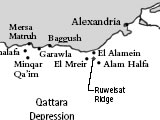What happened that day?
See historic events for any day of the year by entering the date below. Why not try your birthday?
Kiwi of the Week
Today in History

1942 NZ Division helps Allies break through at El Alamein
At El Alamein in Egypt, the 2nd New Zealand Division opened the way for British armour, allowing the Allies to force a breakthrough and send the Axis forces into retreat.
The North African campaign was important to the Allies because of the strategic importance of the nearby Suez Canal and the Middle East oilfields. The New Zealanders had been fighting German and Italian forces around the border between Egypt and Libya since 1941. The Second Battle of El Alamein, which began on 23 October 1942, was to determine the outcome of the Western Desert campaign.
The 2nd New Zealand Division, boosted by two British infantry brigades, was given the responsibility of leading 'Operation Supercharge', which began at 1.05 a.m. on 2 November. The aim was to destroy as many enemy tanks as possible and clear the way for Allied tanks to break through. A seven-hour aerial bombardment lit up the sky like Guy Fawkes' night and was followed by a four-and-a-half hour barrage during which 360 guns fired 15,000 shells.
The fighting during the day was fierce. By the evening of the 2nd, the German Afrika Korps was in a desperate position. With many of his tanks destroyed and fuel supplies low, Field Marshal Rommel began withdrawing the mobile parts of the Axis army. By 4 November it was in headlong retreat, with the British armoured divisions and 2nd New Zealand Division in hot pursuit. With no transport available, thousands of Italian and German troops were taken prisoner. While Rommel lived to fight another day, there was no hiding the fact that the Axis had suffered a decisive defeat.
Image: El Alamein Campaign map














